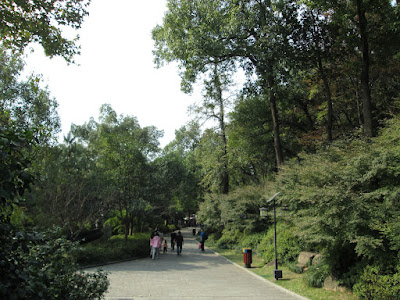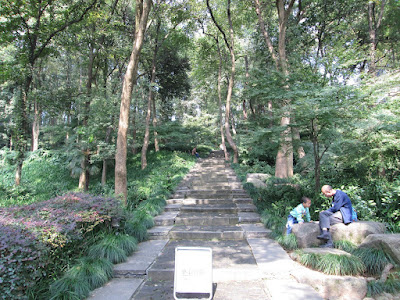It has been a very eventful twelve days indeed, and I intend to blog about it all. The American election took place, with Barack Obama being re-elected. My reaction was, of course, highly analytical and objective, as shown by my Facebook posts:
Totally analytical
On to more important things, however, I decided to take some time to travel outside of Suzhou and see some of the great cities nearby. I decided to go to Hangzhou (杭州) first. For those of you unfamiliar with Hangzhou, the city is famous for a large lake, called West Lake (西湖), that is filled with temples, pagodas, tea plantations, and all-around spectacular beautiful nature, and is easily one of the most popular tourist destinations in China. Many poems have been written about the beauty of Hangzhou's West Lake, and so I very much wanted to see the city for myself.
At Suzhou Train Station (苏州站)
I was worried about going out to Hangzhou myself, but I was pleasantly surprised by the exceptional quality and user-friendly nature of China's train system. It was very straightforward and simple, and without any fuss I found myself on my hour-and-a-half-train ride to Hangzhou.
My view on the train
China's train stations all provide a taxi service, and so I quickly got a taxi and was on my way to my first site at West Lake, the Leifeng Pagoda (雷峰塔).
The ancient Chinese escalator was helpful if you didn't feel like climbing the stairs to get to the pagoda!
Leifeng Pagoda is famous mainly due to its importance in a well-known Chinese story called The Legend of the White Snake (白蛇传), which is essentially the story of a young scholar who falls in love with this beautiful woman, who actually turns out to be this snake spirit. There have been many operas, movies, television shows made about this story, enough that there is a well-sized Wikipedia article available on it if anyone is interested about learning more about the story. The story is also retold inside the pagoda itself through a series of pictures with both Chinese and English captions.
The original Leifeng Pagoda collapsed in 1924 due to mismanagement and disrepair, but was rebuilt in 2002. The original foundations of the building can be seen in a museum below the newly-rebuilt pagoda.
The view from the pagoda offered a spectacular view of both West Lake and Hangzhou.
I was pleasantly surprised at the sheer amount of greenery around West Lake, by far the most I'd seen since I'd come to China. It was a nice change from the dull grey that dominates most Chinese cities.
I was determined to go out on a boat out onto the lake itself, though I was also determined not to have to squeeze myself into one of the painfully tiny ferries filled with loud Chinese tourists. Thus, I decided to go to the shore and purchase an entire raft all for myself. It cost me far more money than what one would usually pay for the service, but I felt the experience was totally worth the cost.

Of course, my choice to go out alone brought its fair share of bemused onlookers, who were obviously jealous that they could not have their own boat to themselves.
Enjoy your overcrowded boat, plebeians!
I was taken to easily the most famous site in West Lake, the Three Ponds Mirroring the Moon (三潭印月). It is so famous, in fact, its picture was put on the 1RMB note.
I was able to see a great view of the shores on my private cruise on West Lake, being sure to take in the scenery that had inspired so many poets, artisans, and rulers over the centuries.
Once getting back ashore, I decided to do a large walk around West Lake, going along the major causeways that connect the shores of West Lake. Unfortunately, most of the other 400,000 visitors to West Lake that day decided to do the same.
There was still a lot more to see and experience in my day at West Lake, so much so that I shall conclude it in my next blog post. Until next time!










































No comments:
Post a Comment